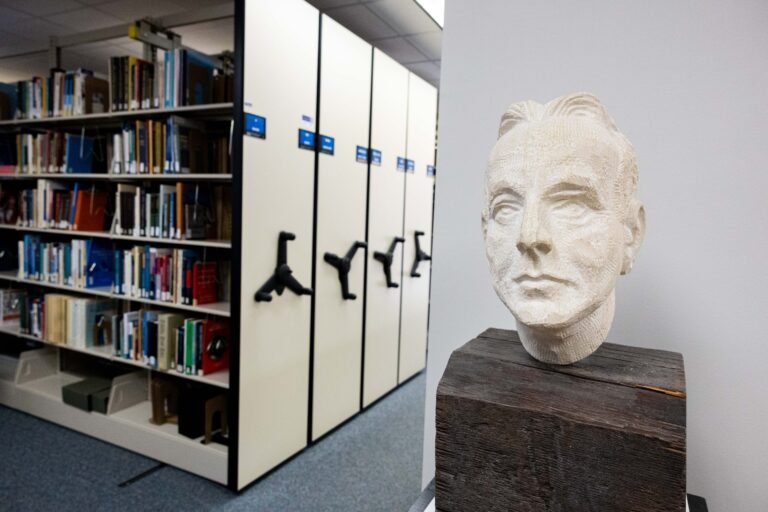Tucked inside a tiny climate-controlled safe in Southwest Research study Institute’s collection are numerous publications you would certainly be tough pushed to discover in other places, consisting of a prohibited publication by Galileo unlawfully duplicated in 1710.
The unusual and distinct publication collection flaunts 250 publications narrating the background of scientific research, design and math at SwRI’s Thomas Baker Glossy Memorial Collection.
SwRI is a not-for-profit r & d institute established in 1947 by the rich oilman, benefactor and traveler Tom Glossy, that likewise established SwRI’s biomedical equivalent and sibling not-for-profit, Texas Biomedical Research Study Institute.
The SwRI collection beings in the center of their 1,500-acre university on the West Side of San Antonio near Culebra Roadway.
Some of the extra remarkable publications being in a tiny screen area with colored home windows to safeguard the web pages and ink from fading.
A plain climate-controlled safe behind the screen area consists of the remainder of the collection, each publication shielded by an archival-quality cardboard instance. The safe remains within a particular moisture and temperature level array, and it depends on a specialized, waterless, fire security system to snuff out a fire without harming guides.

The library collection was curated by previous SwRI leaders Hyman Norman Abramson and Martin Goland in the 1960s and ’70s. Both males would certainly see meetings, conventions and unusual publication shops to acquire distinct messages fundamental to clinical progression. The majority of guides are concentrated on physics, maths and astronomy.
The males accumulated guides by themselves cent, contributing what they bought to the collection. When Abramson passed away in 2022 at the age of 96, he bestowed SwRI $250,000 to proceed contributing to the collection’s collection.
The most recent publication contributed to the collection’s collection was by Scottish researcher Mary Somerville, acquired in 2021.

One of the collection’s objectives is to include even more publications authored by ladies to their collection, according to Valerie Beloved, the curator that manages the collection.
Beloved’s individual favored rarity is a 2010 variation of “Around the globe in 80 Days” by French author Jules Verne initially released in 1872. The 2010 variation was just one of the initial publications to have QR codes on each web page, which worked as web links to on-line afterthoughts and conversation concerning guide’s components. Obviously, the QR codes no more function.
” It is an item of background,” she stated, “and it’s not also that old, and it’s currently damaged.”
The interpretation of a “unusual or unique” publication can be a little bit amorphous, Beloved discussed. Some publications are just taken into consideration unique and unusual due to the fact that they’re authorized or annotated by remarkable numbers, like Tom Glossy, whose trademark shows up in much of guides. The majority of guides are just early, unusual variations of publications published in the 16th century.
The Galileo publication is considered their crown gem. The Italian researcher’s “Discussion Worrying both Principal Globe Equipments” was initially released in 1632. It sets out debates for and versus heliocentrism, the concept that the Planet and various other earths orbit the sunlight, after that believed to be the facility of deep space.
Galileo’s advocacy for this concept outraged Catholic Church authorities, that thought that every little thing orbited around the Planet, identifying his job as in contrast to divine teaching and touchdown his publication on the Index of Forbidden Books.
Many researchers would certainly happen to Galileo’s concept in the coming years, yet the church required one more century to think of it. The variation in SwRI’s belongings is a 2nd version of guide, unlawfully duplicated in Italy in 1710, 6 years after Galileo’s fatality still resting conveniently on the church’s checklist of prohibited publications.
It’s without a doubt the greatest worth publication in the collection, with an approximated assessed worth of $6,000. It was bought by the collection in 1974, for $250.



Other remarkable publications consist of Polish researcher Marie Curie’s critical deal with radioactivity; a publication by Aristotle on weather forecasting, annotated greatly by an unidentified viewers; and a publication by Ptolemy, a Greek-Roman researcher and mathematician that made use of geometry to explain the activity of celebrities and earths. The Ptolemy publication is the earliest in the collection, published in 1556, and still in great problem, Beloved stated.
The unusual publications collection is open to the general public, yet calls for a visit for checking out. Beloved, that has actually been with the collection considering that 2020, stated she’s still finding out about guides, their significance and the writers, commonly relying upon the researchers at SwRI for aid.
” I am not a STEM history individual, like in all,” she stated. “I’m most likely just like 10% of the means done obtaining every one of this.”



